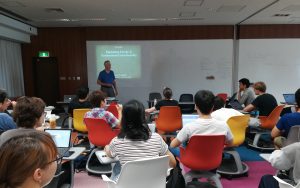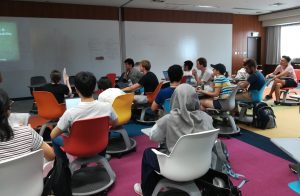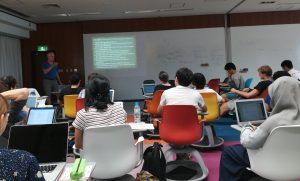(本日から英語による報告となります)
Today, we had a lecture on energy by Brian-sensei. It was part of INTA4813 (Energy, Environment, and Policy) course, and through this lecture, we have looked at different theories and approaches to explain variation in energy and environmental policy-making.

-When we think about energy and environmental policies around the world, some city, region and/or country does better than the other, even though these two different areas have very similar level of economics.. ‐It is often the case that one is economically impossible to achieve lower carbon emissions by increasing reliance on renewable energy even when the objective is being realized through policy-making and social change in broadly similar entities.. -When it comes to a topic like climate change, we still see “deniers” in a certain country more than the other…
To explain those puzzles, Brian-sensei first told us the importance of paying attention to the preferences of the actors involved and the institutions governing the decision-making process. As Veto Players Theory explains, policy outcomes can be explained by the individual and collective actors who have to agree for policy change to occur at the national/local level in a country.
Having these puzzles and the veto player theory in mind, we have discussed the following approaches:
-Rational Choice Approach
-World Systems (dependency) Approach
-Modernization & Development Approach
-Cultural (Idealization) Approach
-Institutionalist Approaches
Rational choice approaches can be understood through the tragedy of commons, where rational choice thinking led to depletion of resources. The tragedy of commons tells us a lesson that the incentives are needed to achieve overall efficiency. In terms of reducing emissions, for instance, the implementation of policies such as effluent tax and cap-and-trade scheme would be necessary to place a price on environmental emissions.

World System Approach is used to explain the linkage between developing countries and developed countries. The idea of this approach comes from the resources flow from a poor state to a wealthier state, which results in enriching the latter at the expense of the former. As carbon dioxide emissions are lager in North America, Europe and Asian and small in South America and Africa, this approach reminded us about how the world retains the traces of slavery even to this day.
Modernization & Development Approach is an approach based on the modernization that a country passes through different stages as it transitions from a traditional society to a high mass consumption society. While explaining this approach to class, Brian-sensei recalled “sustainable development footprint approach” which Adjo-sensei taught us at the beginning of JSPSD2018. “Sustainable development footprint approach” has economic, environmental and social forms of capital and can be applied to assessing progress in sustainable development in space and time.
Cultural Approach can explain the differences between different countries in terms of interpreting frameworks.Culture shapes influence of values, concepts, identities, and symbols. Therefore, social context would vary among culturally different regions. To understand this approach, we have reviewed Abraham Maslow’s hierarchy of needs and Hofstede’s dimensions of culture. We also discussed how we do not see people littering in Japan, while in the US we often see trash in public spaces.
Institutional Approach focuses on roles that formal institution (i.e. laws) and informal institution (i.e. socially shared rules) play. Brian-sensei talked about the challenge of designing institutions and policies that foster social acceptance and sustainability.
After discussing those approaches, students were assigned groups for their INTA4813 project. With this assignment, each research group was tasked to assess policies for promoting energy security in Tokyo and Atlanta. For this project, students are asked to answer the following questions.

Assess approaches for promoting sustainable energy security in the Tokyo and Atlanta metropolitan areas:
- What is the background of energy use and environmental protection in each of these metropolises?
- What strategies have been proposed to ensure energy security and reduce carbon emissions?
- What lessons can each metropolis learn from the other?
- What challenges must be surmounted to realize sustainable economic progress in a manner that assures that the vast majority residents, current and future, share in the benefits?
- In what ways are decision makes enabled or constrained by contextual factors, including national- and /or state\level institutions, policies, and cultural practices?
- How do these metropolises plan to deal with the consequences of possible natural or man-made disaster?
To get started on the groupwork, each group fist looked into some data to see how they want to define “Tokyo” and “Atlanta”. After some discussions within a group as well as between groups, we concluded that by saying “Tokyo”, we will be talking about Tokyo-to, and for “Atlanta”, we will be looking into Atlanta Regional community, which counts for 20 counties in Atlanta city, for the purpose of this project.
There will be a poster presentation for this project, and it will take place on the second to the last day of JSPSD2018, meaning that students have about 2 weeks to work on this project. I am looking forward to hearing what outcomes each group will bring in about 2 weeks.
Written by Kanaha Shoji
Georgia Tech Graduate (2018) in Environmental Engineering, working as a research assistant for JSPSD2018